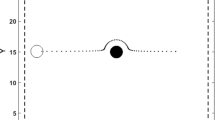Abstract
The behavior of a single and pair of solid particles in particulate flow has been analyzed for different particle shapes. Five different particle shapes are considered which include triangle, ellipse, rectangle, square and a star. Results for each shape are presented by varying their orientations (angle). Numerical experiments are performed for pairs of falling particles which are about to collide and interacting with each other subject to the hydrodynamic forces and the gravitational force. Current study helps in determining the trajectories of different shaped particles and interactions of particle pair with each other while settling in a fluid channel. The hydrodynamic forces acting on the surface of a single falling particle have been calculated using an explicit volume integral approach and the results for drag and lift coefficients have been presented. An Eulerian approach consisting of fixed background mesh has been used in this work. The interaction between particles and fluid has been determined using a fictitious boundary method (FBM). A collision model proposed by Glowinski et al. is used to handle particle-particle interactions. The simulations of particulate flow are carried out using a multigrid finite element solver FEATFLOW.









Similar content being viewed by others
References
Glowinski R, Pan TW, Hesla TI, Joseph DD (1999) A distributed lagrange multiplier/fictitious domain method for particulate flows. Int J Multiph Flow 25(5):755–794
Singh P, Hesla TI, Joseph DD (2003) Distributed Lagrange multiplier method for particulate flows with collisions. Int J Multiph Flow 29(3):495–509
Patankar NA, Singh P, Joseph DD, Glowinski R, Pan TW (2000) A new formulation of the distributed Lagrange multiplier/fictitious domain method for particulate flows. Int J Multiphase Flow 26:1509–1524
Osher S, Fedkiw RP (2001) Level set methods: an overview and some recent results. J Comput Phys 169(2):463–502
Xia Z, Connington KW, Rapaka S, Yue P, Feng JJ, Chen S (2009) Flow patterns in the sedimentation of an elliptical particle. J Fluid Mech 625:249–272
Yokojima S, Takashima R, Asada H, Miyahara T (2021) Impacts of particle shape on sedimentation of particles. Eur J Mech B Fluids 89:323–331
Xiaowu F, Yao Z, Zhang X (2017) Numerical simulation of polygonal particles moving in incompressible viscous fluids. Particuology 31:140–151
Wachs A (2009) A dem-dlm/fd method for direct numerical simulation of particulate flows: sedimentation of polygonal isometric particles in a newtonian fluid with collisions. Comput Fluids 38(8):1608–1628
Pillapakkam SB, Singh P (2001) A level-set method for computing solutions to viscoelastic two-phase flow. J Comput Phys 174(2):552–578
Munjiza A, Owen DRJ, Bicanic N (1995) A combined finite-discrete element method in transient dynamics of fracturing solids. Eng Comput 12:145–174
Mishra BK, Rajamani RK (1992) The discrete element method for the simulation of ball mills. Appl Math Model 16(11):598–604
Potapov Alexander V, Hunt Melany L, Campbell Charles S (2001) Liquid-solid flows using smoothed particle hydrodynamics and the discrete element method. Powder Technol 116(2–3):204–213
Wan D, Turek S (2007) Fictitious boundary and moving mesh methods for the numerical simulation of rigid particulate flows. J Comput Phys 222(1):28–56
Hirt CW, Amsden AA, Cook JL (1974) An arbitrary Lagrangian-Eulerian computing method for all flow speeds. J Comput Phys 14(3):227–253
Maury B (1996) Characteristics ale method for the unsteady 3d Navier–Stokes equations with a free surface. Int J Comput Fluid Dyn 6:175–188
Sarrate J, Huerta A, Donea J (2001) Arbitrary Lagrangian-Eulerian formulation for fluid-rigid body interaction. Comput Methods Appl Mech Eng 190(24):3171–3188
Hu Howard H, Patankar NA, Zhu MY (2001) Direct numerical simulations of fluid-solid systems using the arbitrary Lagrangian-Eulerian technique. J Comput Phys 169(2):427–462
Maury B (1997) A many-body lubrication model. J Comput Appl Math 325(9):1053–1058
Jabeen S, Usman K, Walayat K (2020) Numerical investigations for a chain of particles settling in a channel. Comput Particle Mech 7(4):615–627
Usman K, Walayat K, Mahmood R, Jabeen S (2022) Wall effects on a falling solid particle in an infinite channel. Fluid Dyn Res 54(1):015514
Zhang N, Zheng ZC (2007) A collision model for a large number of particles with significantly different sizes. J Phys D Appl Phys 40:2603–2616
Sommerfeld M (2001) Validation of a stochastic Lagrangian modelling approach for inter-particle collisions in homogeneous isotropic turbulence. Int J Multiph Flow 27(10):1829–1858
Jabeen S, Usman K, Shahid M (2022) Numerical study of general shape particles in a concentric annular duct having inner obstacle. Comput Particle Mech 9(3):485–497
Usman K (2013) Numerical analysis of collision models in 2d particulate flow. Ph.D. thesis, Technische Universität Dortmund, Fakultät für Mathematik
John V (2002) Higher order finite element methods and multigrid solvers in a benchmark problem for the 3d Navier-Stokes equations. Int J Numer Methods Fluids 40:775–798
Wendt JF (ed) (2009) Computational fluid dynamics. Springer, Berlin
Wan D, Turek S, Rivkind LS (2004) An efficient multigrid fem solution technique for incompressible flow with moving rigid bodies. Numer Math Adv Appl (Miloslav Feistauer, Vit Dolejsi-, Petr Knobloch, and Karel Najzar, eds.), Springer, Berlin, pp 844–853 (English)
Kim SS, Karrila SJ (1991) Microhydrodynamics: principles and selected applications. 2nd ed., Butterworth-Heinemann, Boston
Usman K, Ali J, Mahmood R, Bilal S, Jabeen S, Asmat J (2020) Study of a falling rigid particle passing around obstacles in a fluid channel. Int J Comput Fluid Dyn 34(9):644–655
Turek S (1998) Featflow finite element software for the incompressible navier-stokes equations: User manual, release 1.1. Tech. report
Author information
Authors and Affiliations
Corresponding author
Ethics declarations
Conflicts of interest
On behalf of all authors, the corresponding author states that there is no conflict of interest.
Additional information
Publisher's Note
Springer Nature remains neutral with regard to jurisdictional claims in published maps and institutional affiliations.
Rights and permissions
Springer Nature or its licensor (e.g. a society or other partner) holds exclusive rights to this article under a publishing agreement with the author(s) or other rightsholder(s); author self-archiving of the accepted manuscript version of this article is solely governed by the terms of such publishing agreement and applicable law.
About this article
Cite this article
Shahid, M., Usman, K. Kinetics of suspended particles with different shapes interacting in a fluid channel. Comp. Part. Mech. (2023). https://doi.org/10.1007/s40571-023-00684-w
Received:
Revised:
Accepted:
Published:
DOI: https://doi.org/10.1007/s40571-023-00684-w




